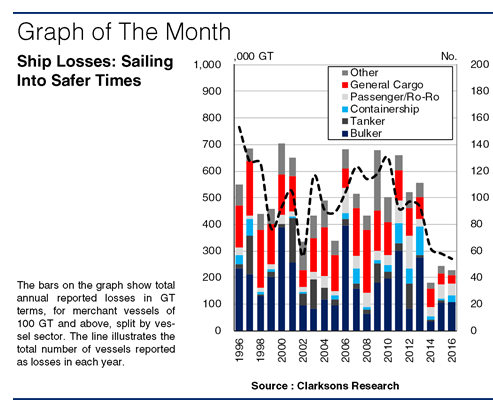Clarksons: Vessel Losses – Sailing into Safer Times?

With the improved safety at sea, total vessel losses seem to be on a downward trajectory. 2016 marked the fewest number of ship losses on record although the world fleet reached its greatest ever size, Clarksons Research said.
In 2016, reported losses reached a historically low level of 54 vessels and 0.2 million gross tons, equivalent to just 0.02% of the start year fleet in gross tonnage terms, according to Clarksons.
Merchant ships have in recent times been an extremely low-risk form of transport. The decrease in total losses – when vessels are permanently lost from the fleet due to sinkings, groundings or other incidents – has been attributed to an improved ship design, an increased number of port state control inspections and a decline in the proportion of vessels above 25 years old.
 Looking at the statistics across the major vessel types, losses have typically been greatest in the bulk carrier sector.
Looking at the statistics across the major vessel types, losses have typically been greatest in the bulk carrier sector.
From 1996 to 2016, a total of 160 bulkers of 3.7 million gross tons were reported as casualties, accounting for 36% of the total in tonnage terms. On average, bulker losses each year were equivalent to 0.09% of start year bulk carrier tonnage.
In comparison, the total volume of tanker and containership tonnage reported as losses in the same period represented 9% and 5% respectively of total losses – totaling 143 tankers and 49 boxships.
Average annual tanker and boxship losses in gross tonnage were equivalent to 0.02% and 0.03% of the start year fleets in each sector.
In the bulk carrier sector, losses of larger ships have been more common, with an average vessel size of 23,247 gross tons, against 6,181 gross tons for tankers. This is likely to have been supported by stricter regulation on tanker designs since the 1990s as well as improved vetting procedures, Clarksons explained.
Sectors with a large number of smaller units represent the majority of losses in numerical terms. In general, smaller ships account for a larger proportion of casualties, with the average size of losses peaking at around 7,600 gross tons in 2000.
From 1996 to 2016, 1,033 general cargo ships were reported as losses, making up 50% of the total in numerical terms.
Meanwhile, 184 vessels were recorded as losses in the same period in the passenger and roll-on/roll-off (RoRo) sectors. Aside from a number of high profile larger vessels such as Costa Concordia and Sewol, the majority of these casualties were small passenger ferries, predominantly in South East Asian waters.
Although the long-term trend of declining vessel losses appears to have continued over the last few years, there is still a significant degree of variation between sectors, with older and smaller vessels also much more likely to become casualties, Clarksons pointed out.
“Whilst risk very much remains a part of shipping, the last few years appear to show that merchant shipping is still improving its safety record, with the number of vessel losses continuing to fall,” according to Clarksons.
HEADLINES
- Do shipping markets want Biden or Trump for the win?
- All 18 crew safe after fire on Japanese-owned tanker off Singapore
- Singapore launching $44m co-investment initiative for maritime tech start-ups
- Cosco debuts Global Shipping Industry Chain Cooperation Initiative
- US warns of more shipping sanctions
- China continues seaport consolidation as Dalian offer goes unconditional